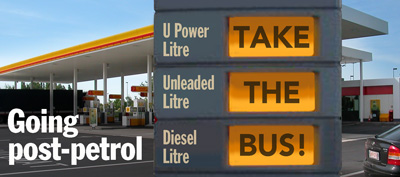Peak oil
doomerism is the notion that once we reach the peak, the decline will be rapid, all mitigation efforts will be next to useless and things will unfold too fast for any party to control - all this resulting us plunging into new dark age of anarchy. You know, Mad Max and all that.
There is a smallish, but growing and often vocal part of peak oil followers who subscribe to different levels and types of doomerism.
There are
gung-ho survivalists ('Bring it on! I've got my guns loaded'),
practical planners ('I've got lots of food stacked and am learning the basics of thrifty living'),
financial security seekers ('How can I make money off peak oil, so I can end up on top when things fall apart'),
eschatological christians ('This is god's punishment, you all deserve it, but I'm going to heaven') and
Bayesian realists ('Yes, such a breakdown is a probability, but one which total likelihood is very difficult to assess and one which can be affected by one's own actions, so it's better to work to improve the positive than pre-emptively to start feeling sorry for oneself').
Now, we don't subscribe to doomerism here, with perhaps an exception of bayesian realism, which is based on notions of risks and unknowability.
The future is way too chaotic to plan, assess or to even know fully. It merely unfolds with all of it's surprises and often with a kind of glacial slowness, especially when compare to to how fast people thought things would unfold.
Further, it is important to look at history for clues: what happens when societies are starved for their lifeblood, the very essence that keeps the going: energy.
Joseph Tainter's and Jared Diamond's books on historical societal collapses offer some clues. Both have recognizes resource starvation as one reason for historical societal collapse. Energy of course is the ultimate resource, without which even life is not possible.
So, collapse is a possibility, but so is downsizing.
Downsizing societies means cutting down the complexity of societal functions to the level where energy is not 'wasted' to such a huge degree by most of the citizens. People will have to think what they do for their food, heating energy, building power and mobility. Think Energy Return on Energy Invested (
EROEI). This
cannot be measured in dollars, it can only be measured in units of energy (kJ, kWh, etc). In a peak oil scenario energy is not free anymore in the sense it is today: it is not always available and when it is, the associated costs are very high and required outputs for the use of that energy determine the basic livelihood.
This requires downsizing of needless activities. It is important to remember also that 'needless' is always defined as a function of energy surplus: the more you have energy, the more of the previous needless activities become everyday standards and eventually seen as needed. The less energy you have and the reverse happens.
Societal changes take time: it is quite difficult for people to change unless there is a sudden state of emergency that binds everyone together to act in unison (think war). As such, the energy transitions need also be slow, to accommodate for the slowness in change of society.
Herein lies the crucial point when deciding about whether to be a doomer or not.
If you believe that the decline in available primary energy sources (oil, alternatives, coal, natgas) will be faster than the society's ability to cope with such decline, then the probability of a collapse rises.
If you believe that societies have an ability to downsize their activities and act in co-ordinated manner, when they have foreknowledge of what is to come, then an ordered transition is more likely.
How much of a transition and for how long a period is needed, that is anybody's guess. The point is relative speed of change here. Which changes faster: the availability of fuels or the societies' actions pre-empting this?
Now, some of you are crying that there is a third way: that there will not be any energy shortage. We'll just find or invent other energy sources that will supplant all fossil fuels, esp. the liquid types and bingo - problem solved.
This is another type of faith based position bordering on fallacy, not too distant removed from doomerism in it's structure. But that is a topic for another post.
Getting back to doomers, it appears that many of them do not have a lot of faith in the society, esp. the government. As such it is perhaps not a great surprise that a majority of doomers hail from the USA, where suspicion towards the government has always run quite high.
Another part of the doomer camp may not be so suspicious about the government, but they see the challenge ahead as so big in terms of infrastructure, manpower, money, time and natural resources - that they think no society, regardless of how perfect, will be able to pull it off. So, collapse it is for them as well.
Now, there are obvious probabilistic fallacies in both of these lines of reasoning. The first assumes that the government will always screw up, no matter what. The people in power and the context of the situation do not matter. Government is the Super-Murphian Fail-o-Tron, incapable of doing good.
The second line of reasoning assumes that the scale is so big that nothing can be done. This reasoning is problematic on two accounts. First is the idea that the scale, the speed of change and all possible new interventions are known in advance and can be assessed (aka 'the future can be known' fallacy). The second is the dichotomic either/or fallacy: either we can fend this off and continue business as usual, or then it's collapse. There appear no shades of grey in-between.
The government failing line of reasoning is a faith based fallacy, it cannot be argued against, as it really is not an argument. It is pure faith. One either has the religion or not. No amount of data or reasoning will convince most of these people otherwise.
The scale issue is more hard to tackle, but it also contains elements of faith: a belief that the future can be known combined with a lack of faith for positive surprising new developments, and faith that the scale of changes needed is indeed significantly bigger/faster than that of society's ability to carry out, and remains so throughout the whole ordeal.
The dichotomic thinking is a basic human reasoning fallacy, it is likely to be part of our evolutionary survival instinct that when we are faced with a threat of disproportionate size that is difficult to rapidly assess intellectually, we succumb to the 'fight or flight' type of polarize thinking. All other options disappear and the limbic system makes the decision for us. The only cure for this is post-shock rational analysis. Once we get over the initial shock and understand that the world didn't end, we can actually start assessing some parts of the situation and start acting on that information. Even if we still don't know the whole picture or know how things will turn out.
With all that said, it should be obvious to any reader that the likelihood of a severe transition, lots of difficult decisions and even a small probability of collapse has not gone away.
One should always remember that just like the dystopian future cannot be proven with 100% probability, the same stands for the utopian future.
More than that, the future is more than likely to be something in between (aka a shade of grey).
So, to mentally prepare, one can and maybe even should play thought games, but one should also never delude oneself to think that the evidence on table has finally and completely proven either future we us.
After all, there really is no fate, except what we make for ourselves.











![]()

![]()

![]()

![]()



![]()

![]()

![]()

![]()

![]()
![]()


![]()
